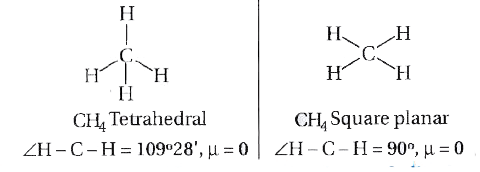Apart from tetrahedral geometry, another possible geometry for CH4 is square planar with the four H atoms at the corners of the square and the O atom at its centre. Explain why CH4 is not square planar ?
Experimentally dipole moment of CH4 is μ = zero so, CH4) molecule is nonpolar.

Topper's Solved these Questions
- BOOK - KUMAR PRAKASHANCHAPTER - CHEMICAL BONDING AND MOLECULAR STRUCTUREEXERCISE - TRY YOUR SELF-31videos
CHEMICAL BONDING AND MOLECULAR STRUCTURE
- BOOK - KUMAR PRAKASHANCHAPTER - CHEMICAL BONDING AND MOLECULAR STRUCTUREEXERCISE - TRY YOUR SELF-41videos
CHEMICAL BONDING AND MOLECULAR STRUCTURE
- BOOK - KUMAR PRAKASHANCHAPTER - CLASSIFICATION OF ELEMENTS AND PERIODICITY IN PROPERTIES EXERCISE - Section -D SOLUTIONS OF NCERT EXEMPLAR PROBLEMS (Long Answer Type Questions )7videos
CLASSIFICATION OF ELEMENTS AND PERIODICITY IN PROPERTIES
Similar Questions
Apart from tetrahedral geometry, another possible geometry for CH4 is square planar with four
H atoms at the corners of the square and the C atom as its centre . Explain why CH4 is not square planar .View SolutionIf the geometry of [PtCl4]2− is square planar, which orbitals of Pt are involved in the bonding ?
View Solution
Knowledge Check
- Question 1 - Select One
Which has square planar geometry
A[Pt(NH3)2Cl2]B[Ni(CN)4]2−CBoth (a) and (b)DNone of these - Question 2 - Select One
Geometrical isomerism arises in heteroleptic complexes due to different possible geometrical arrangement of the ligands. Important examples of this behaviour are found with coordination number 4 and 6. Such isomerism is not possible for a tetrahedral geometry but it is possible for square planar as well as octahedral complexes. Optical square planar as well as octahedral complexes. Optical square planar as well as octahedral complexes. Optical isomers are mirror images that cannot be superimposed on one another. These are called enantiomers. Optical isomerism is common in octahedral complexes involving bedentate ligands.
Which one of the following statements is false ?A[cis−Pt(NH3)2Cl2] will have some dipole momentB[cis−Pt(NH3)2Cl2] will show geometrical as well as optical isomerism.Ccis−[CrCl2(ox)2] is a chiral molecules.D(a) and (b) both - Question 3 - Select One
Geometrical isomerism arises in heteroleptic complexes due to different possible geometrical arrangement of the ligands. Important examples of this behaviour are found with coordination number 4 and 6. Such isomerism is not possible for a tetrahedral geometry but it is possible for square planar as well as octahedral complexes. Optical square planar as well as octahedral complexes. Optical square planar as well as octahedral complexes. Optical isomers are mirror images that cannot be superimposed on one another. These are called enantiomers. Optical isomerism is common in octahedral complexes involving bedentate ligands.
Select the correct statement.ABoth [NiCl2(PPh3)2] and its analogous Pd(II) show geometrical isomerism.B[CoBrCl(en)2] will show geometrical isomerism but is chiral compound.Ccis−[Co(NH3)4Br2]+ can exist as enantiomerDA complex of palladium (II) with two chloride ions and two thiocyanate ions will show linkage as well as geometrical isomerism.
If the geometry of [PtCl4]2− -is square planar, which orbitals are involved in bonding?
View SolutionIf the geometry of the complex [PtCl4]2− is square planar, which type of orbitals are involved in its hybridisation?
View SolutionWhat is the coordination number of the metal atom if its geometry is (i) square planar (ii) octahedral?
View SolutionWhy Ni(CO2)4 is tetrahedral while [Ni(CN)4]2− is square planar?
View SolutionAmong the following the square planar geometry is exhibited by:
View Solution

